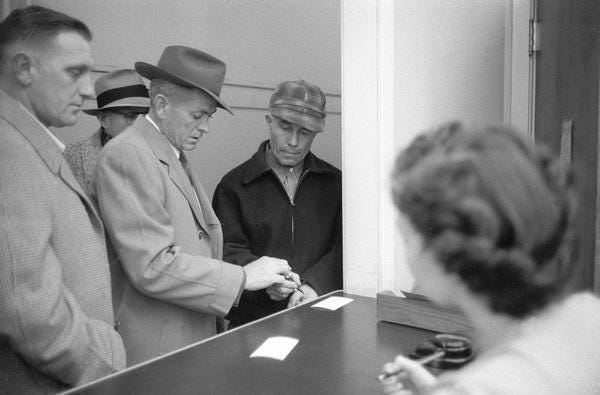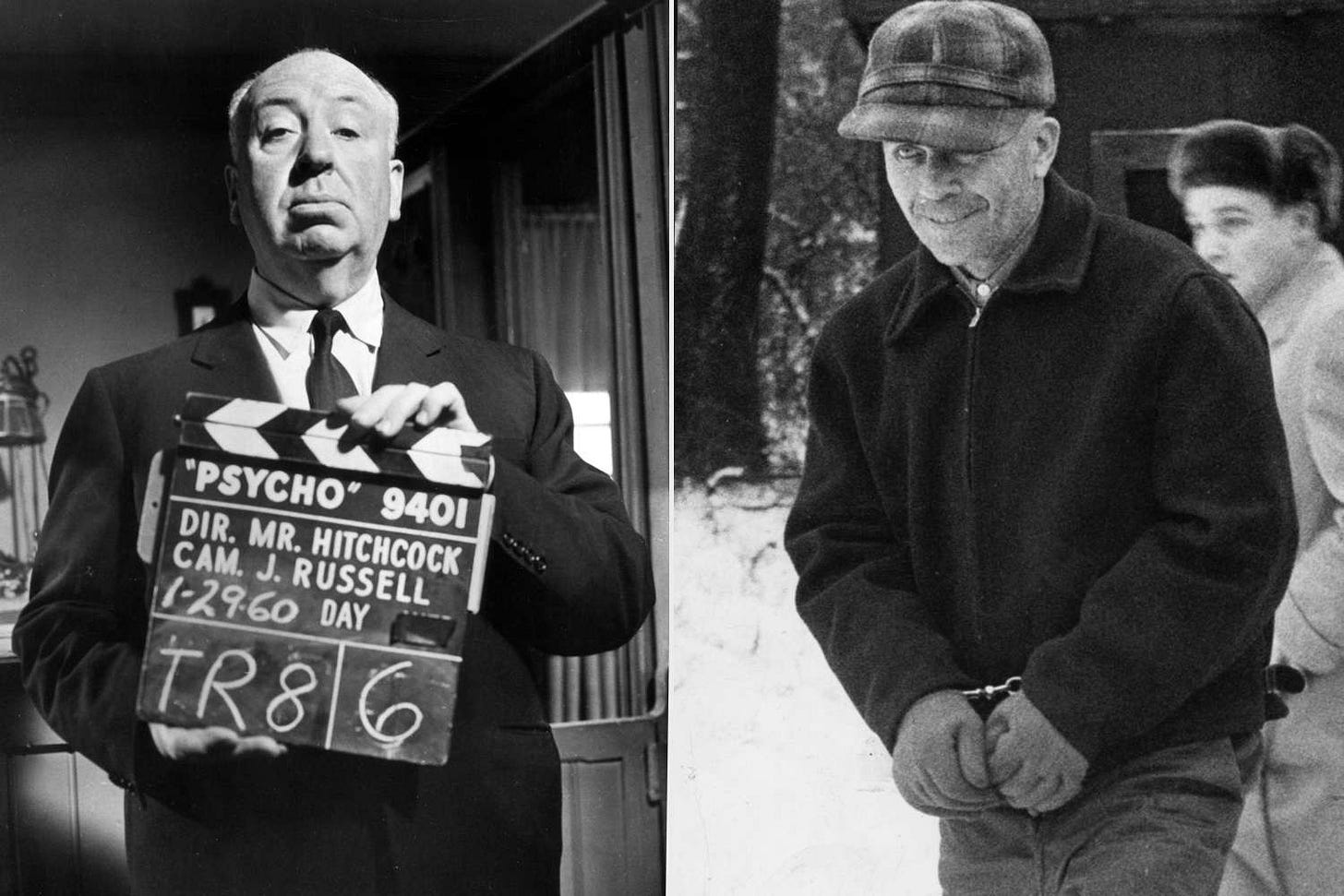The Sickening Crimes of Eddie Gein & Timeline of his Crimes
Edward Gein, also known as Eddie Gein, the Butcher of Plainfield, or the Plainfield Ghoul. His name alone has become synonymous with horror. While most killers fade into history, Gein’s story still haunts our cultural imagination decades later. He didn’t kill dozens or stalk victims across state lines. What made him infamous wasn’t the number of his crimes — but the nature of them. The world wasn’t ready for what would be discovered inside his lonely, isolated farmhouse in Plainfield, Wisconsin. 🩸
His disturbing life inspired some of Hollywood’s darkest creations — Norman Bates from Psycho, Leatherface from The Texas Chainsaw Massacre, and Buffalo Bill from The Silence of the Lambs. But reality, as it often does, turned out to be far worse than fiction.
This is the story of Edward Gein — his life, his psychological unraveling, and the chilling timeline of his crimes that would earn him the title of Wisconsin’s most notorious killer.
Early Life: Born Into Control and Isolation 😶🌫️
Edward Theodore Gein was born on August 27, 1906, in La Crosse County, Wisconsin. He grew up in a loveless, abusive home dominated by an extreme, religiously fanatic mother and a weak, alcoholic father.
His mother, Augusta Gein, was a domineering mother who controlled the family with fear and religious shame. She believed women were sinful and corrupt and warned her sons that the world was filled with evil and temptation. Ed and his older brother Henry weren’t allowed to have friends. They were isolated from the town and raised to believe that pleasure was a sin and women were evil.
His father, George Gein, was emotionally absent and violently drunk. Augusta resented him and made sure her sons viewed her as their only moral guide. Growing up under such emotional dominance, young Ed never developed normal social relationships. Instead, he developed an unhealthy emotional dependence on his mother that would shape everything that followed.
The Deaths That Changed Everything ☠️
1940: Ed’s father, George Gein, died from heart failure. 1944: Ed’s brother Henry Gein died under suspicious circumstances during a fire on the property. Though Ed led authorities to the body, questions lingered — Henry had unexplained injuries on his head. Many now suspect Ed may have killed him. 1945: Augusta died after suffering two strokes.
Her death shattered Ed. He had lost the only human he truly connected with. He sealed off her room and turned it into a shrine. The rest of the farmhouse fell into decay — filth piled up, dishes rotted in the sink, and newspapers and junk covered every surface. Ed stopped maintaining himself or his home. His mental state began to unravel. 💀
Life Alone: The Beginning of Madness 🪓
Gein became increasingly withdrawn. He supported himself by doing handyman work around Plainfield. Neighbors described him as odd but harmless. Quiet. Polite. Strange, but not threatening.
But inside his home and inside his mind, a darker world was forming.
He began reading about cannibals, headhunters, anatomy, and body snatching. He developed a fascination with death — not in a violent way at first, but in a strange, childlike obsession with human anatomy and the female body. He admitted later that he wanted to “become a woman” — not out of sexuality, but to feel closer to his mother.
This emotional collapse — paired with isolation and psychosis — pushed Gein to cross lines no one could imagine.
The Secret Body Snatcher ⛏️
In his 1957 confession, Gein revealed something that stunned investigators: he had been robbing graves for years. He claimed he would enter a “trance-like state,” dig up recently buried women who resembled his mother, and bring their bodies home. This earned him the moniker of “body snatcher” among investigators.
But why?
Psychologists believe Gein suffered from severe pathological grief — he couldn’t accept his mother’s death. His grave robbing was his way of “bringing her back” into his life. His crimes were not just physical — they were emotional and ritualistic.
The First Known Victim: Mary Hogan (1954) ❗
On December 8, 1954, Mary Hogan, a tavern owner in Plainfield, vanished from her establishment. Only a pool of blood was left behind. No clues. No suspect. The town was baffled.
Locals joked about Ed’s strange comments. At one point, he said: “Mary Hogan isn’t missing. She’s at my house right now.”
People laughed. It was just Ed being Ed — creepy but harmless.
They were wrong. This would be the first confirmed murder in Plainfield attributed to Gein.
The Murder of Bernice Worden (1957) — The Day the Horror Was Found 🔎
On November 16, 1957, Bernice Worden, a hardware store owner, disappeared from her Plainfield store. The last receipt written that morning was for antifreeze — sold to Ed Gein.
Deputy Sheriff Frank Worden, Bernice’s son, immediately suspected Ed. Police drove to his farm — a lonely, rotting house surrounded by abandoned machinery and silence.
What they discovered would haunt them forever.
Inside the House of Horrors 😱
Police entered a dark shed behind the house — and found Bernice Worden’s decapitated body, hanging upside down. She had been shot with a .22 caliber rifle and mutilated after death.
Then they went inside the farmhouse. What they found was beyond comprehension:
Human skulls used as bowls 💀
A chair upholstered with human skin
A box full of noses
Masks made from human faces
Lips nailed to a string — used as a window pull
A belt made of human nipples
A skin suit and female torso, crafted from human remains
Mary Hogan’s head in a paper bag
Bernice Worden’s heart near the stove
This wasn’t just murder — it was ritual. It was obsession. It was psychosis in its darkest form.
The Woman Suit 🧥
Among the gruesome artifacts in his home, one item raised the most questions: a human skin suit.
Gein admitted to wearing it. He said he would put it on and pretend to be his mother — walking around the farmyard at night dressed in human skin. He spoke of it calmly, like a man describing a coat he made.
Psychologists later described this behavior as a delusion born from identity confusion and psychological regression. He wasn’t killing for pleasure. He was trying to resurrect his mother by becoming her.
Timeline of Ed Gein’s Crimes 📅
1906 Ed Gein born in La Crosse, Wisconsin 1940 Father dies 1944 Brother Henry dies under suspicious circumstances1945 Mother dies, Ed becomes isolated 1954 Mary Hogan disappears 1957 Bernice Worden murdered 1957 Police raid farmhouse 1958 Gein ruled mentally unfit, sent to Central State Hospital 1968 Gein declared fit for trial 1968 Found guilty but insane by Judge Robert Gollmar 1984 Ed Gein dies in mental institution
Psychological Breakdown 🧠
Ed Gein was diagnosed with schizophrenia and severe psychosis. Expert analysis suggests he may have had:
Oedipal fixation– deep emotional attachment to his mother
Gender identity disturbance– desire to transform into his mother figure
Disassociation– entering “trance states” to commit crimes
Necrophilic tendencies– emotional attachment to the dead
Yet despite all of this, he was described by nurses as friendly and polite during his years in custody. They said he was quiet, compliant — even gentle. Some even referred to him as a “model patient” in the geriatric ward.
That may be the most terrifying part. Monsters don’t always look like monsters.
Trial, Sentence, and Death ⚖️
Gein was found guilty of murder in 1968 but declared legally insane. He spent the rest of his life in mental institutions, including Central State Hospital. Visitors described him as childlike, almost happy to have structure and meals. He painted, read adventure books, and cracked jokes.
He died from lung cancer and respiratory failure on July 26, 1984, at age 77. He never expressed remorse.
Cultural Impact 🎬
Ed Gein didn’t kill dozens. He wasn’t a serial killer in the typical sense. But his story terrified the world because it forced us to confront a truth: Evil doesn’t always look dangerous. Sometimes it lives alone. Quiet. Friendly. Ordinary.
His story inspired:
Norman Bates (Psycho, 1960) - directed by Alfred Hitchcock
Leatherface (The Texas Chainsaw Massacre, 1974)
Buffalo Bill (The Silence of the Lambs, 1991)
Ezra Cobb (Deranged, 1974)
Author Robert Bloch, who wrote the novel “Psycho,” was inspired by Gein’s crimes. The case changed how America understood insanity, crime scenes, grave robbing laws, and psychological profiling.
Ed Gein’s Horrors 🕯️
Ed Gein is proof that horror doesn’t always come from the shadows. Sometimes it comes from grief, isolation, and emotional decay — a lonely man, trapped in a warped devotion to his mother, descending into madness one night at a time.
His case forces us to ask: What happens when society ignores broken people? How many warnings were missed in Plainfield? Could Ed Gein have been stopped earlier?
We may never know. But one thing is certain: The quiet town of Plainfield, Wisconsin, in Waushara County, will never be forgotten — because of the man who turned an isolated farmhouse into a nightmare.
Aftermath and Investigation
The investigation into Gein’s crimes was extensive. Sheriff Art Schley led the initial search of Gein’s property, with Deputy Frank Worden playing a crucial role. Gein was subjected to a lie detector test, which he passed, adding to the complexity of the case.
Investigators also looked into the disappearances of other local women, including Georgia Jean Weckler and Evelyn Grace Hartley, though Gein was never conclusively linked to these cases. Another potential victim, Victor Harold Travis, was also investigated in connection with Gein.
The Ford sedan Gein used was found to contain human blood, further implicating him in the murders.
Legacy and Public Reaction
In the aftermath of Gein’s arrest, his house and property became a macabre tourist attraction. Curiosity seekers tried to obtain souvenirs before authorities burned the house down. Gein’s car and other possessions were sold at a public auction, much to the dismay of many who felt it was in poor taste.
The Plainfield Cemetery, where Gein had robbed graves, implemented new security measures to prevent future desecrations.
Today, the story of Ed Gein continues to fascinate and horrify, serving as a chilling reminder of the darkness that can lurk behind an ordinary facade in small-town America.













